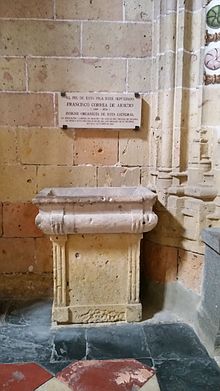Francisco Correa de Arauxo
Francisco Correa (de Arauxo, de Acebedo) (baptized September 16, 1584 in Seville , † October 31, 1654 in Segovia ) was an Andalusian organist and composer on the border between Renaissance and Baroque .
Live and act
Francisco Correa de Arauxo, son of a craftsman, held his first position as organist at the age of 15 from September 1599 in the Church of San Salvador in Seville . He was ordained a priest in 1608. Long-term quarrels and harassment, which Correa was exposed to in the local priesthood, led to unsuccessful applications at several Spanish cathedrals . It was not until 1636 that he was able to move to Jaén's cathedral as organist . A little later, in 1640, he improved himself to become the cathedral organist of Segovia , where he died in 1654.
Correa's importance in music history is based on his organ school, the collection Libro de tientos y discursos de musica practica, y theoretica de organo, intitulado Facultad Organica , which was printed in Alcalá de Henares in 1626 . It contains not only 69 tientos (many for split registers , a specialty of Spanish organs), intabulations and elaborations of liturgical chants, but also detailed instructions for organ playing, which contain informative information on the performance practice of the time. Outside of the Facultad Organica , no composition by Correa has survived.
To a large extent, his music still has the contrapuntal and harmonious flow of the music of the Renaissance , but united with the compelling rhythm and virtuoso melisms that are typical of the Spanish music of his time.
literature
- Charles Jacobs: Francisco Correa de Arauxo. Nijhoff, 1973, ISBN 90-247-1568-7 .
- Iina-Karita Hakalahti: Maestro Francisco Correa de Arauxo's (1584–1654) Facultad orgánica (1626) as a Source of Performance Practice. (PDF; 1.6 MB) Helsinki University Print, 2008.
- Marta Serna-Medrano: Orden y sentido en los tientos o discursos prácticos de Francisco Correa de Arauxo. La Facultad orgánica (Alcalá, 1626) in context . Madrid: Sociedad Española de Musicología, 2017.
Web links
- Sheet music and audio files by Francisco Correa de Arauxo in the International Music Score Library Project
References and footnotes
- ↑ gothicstorage.com translated: Book of Tientos and Discursos of Practical and Theoretical Organ Music Entitled 'Facultad orgánica.' .
| personal data | |
|---|---|
| SURNAME | Correa de Arauxo, Francisco |
| ALTERNATIVE NAMES | Francisco Correa de Acebedo |
| BRIEF DESCRIPTION | Andalusian organist and composer |
| DATE OF BIRTH | baptized September 16, 1584 |
| PLACE OF BIRTH | Seville |
| DATE OF DEATH | October 31, 1654 |
| Place of death | Segovia |

